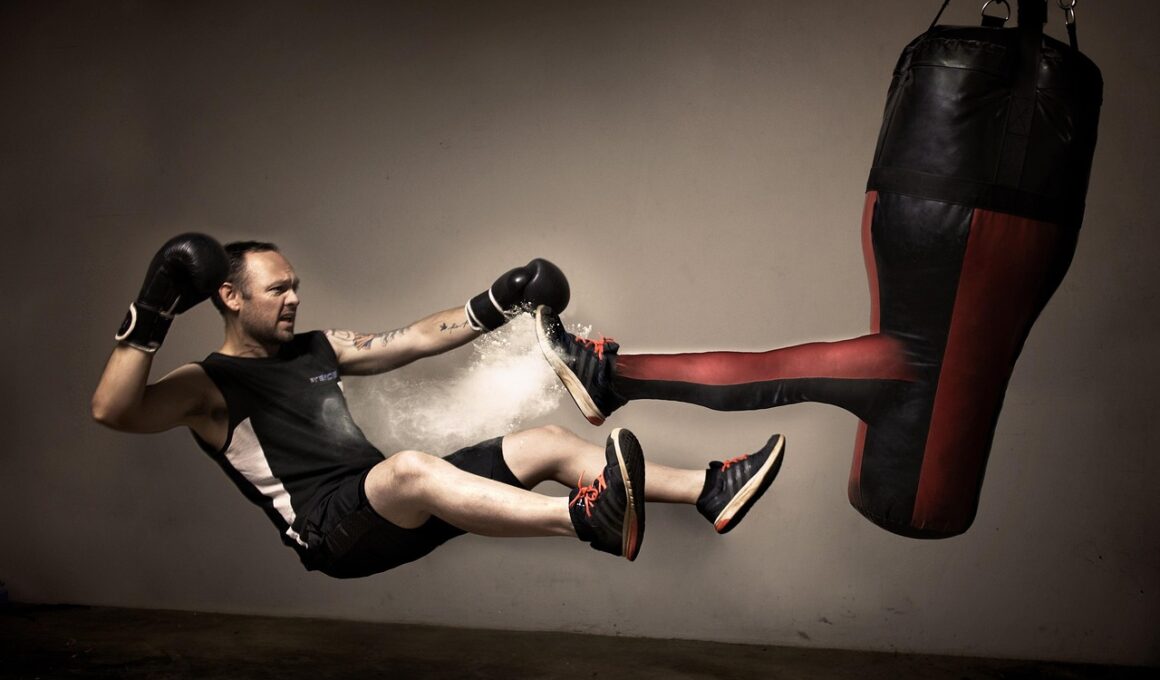How to Track Progress with Kickboxing Bag Workouts
Tracking your progress in kickboxing bag workouts is essential for growth and motivation. Begin by establishing clear and measurable goals. These could range from improving your punching speed to enhancing your endurance. Keeping a journal or using a fitness app can help you log your workouts consistently. Write down the number of rounds you complete, the duration, and specific drills you perform. This will give you a baseline to compare against in future sessions. Additionally, consider taking videos of your workouts. Watching these videos can help you critique your form and technique, identifying areas needing improvement. Another effective method is to incorporate strength benchmarks. Use exercises like push-ups, sit-ups, and squats alongside your bag work. Linking these to your bag routines can provide a holistic view of your fitness journey. Regularly revisit your established goals. Adjust them as needed based on your progress and new insights. Lastly, consider sharing your journey with others, whether online or in a fitness community. Interactions with fellow kickboxers can provide extra encouragement and motivation to maintain your training routine over time. In turn, this community aspect may enhance your dedication and persistence.
One effective strategy is to create a workout schedule dedicated specifically to bag workouts. This schedule should include various drills focusing on different techniques, such as jabs, hooks, and uppercuts. Rotate these drills to keep your workouts fresh and engaging. Consider setting aside specific days of the week for high-intensity intervals. On these days, maximize your effort within shorter time frames. Track how many rounds you’re able to complete during each session, aiming for gradual progression. Incorporating resistance training can also enhance your bag workouts. For instance, perform strength exercises like dumbbell snatches and kettlebell swings to complement your kickboxing routine. Monitor improvements in these strength exercises alongside your bag work to create a comprehensive tracking mechanism. Furthermore, evaluating your stamina is crucial. You could do this by timing yourself on how long you can maintain high-intensity efforts before fatigue sets in. This metric can be recorded separately and will illustrate your advancements in endurance over time. Maintaining a record of your weight, body measurements, and other health indicators can provide additional insights, ensuring your kickboxing journey remains comprehensive and effective.
Techniques to Measure Improvements
Incorporating various techniques can significantly help in measuring your improvements. For instance, focus on a combination of endurance, strength, speed, and technique assessments. A simple yet effective way to assess your capabilities is through interval training—a method that can be extremely beneficial on a punch bag. During each session, keep a timer and attempt to increase the time you spend in high-intensity efforts gradually. Another useful tool is maintaining a workout summary sheet where you note down the details of every session. Include your feelings during and after each workout. Over time, this will enable you to see how far you’ve come in terms of exertion levels and recovery. Utilizing wearable fitness trackers can be impressive, too. These devices can monitor heart rates and calories burned, providing quantitative data that showcases your improvements. If possible, engage with a coach to receive professional feedback on your technique and overall performance. They can offer insights and corrective measures to ensure you’re training efficiently. By continuously adapting and upgrading your training methods based on observed outcomes, you can optimize and maximize your results in kickboxing bag workouts.
Another effective means of tracking your progress is through fitness assessments. These assessments can evaluate skills such as agility, coordination, and power. Performing agility drills and simple plyometric tests before and after a training block showcases how much you’ve improved. Linking these exercises to your kickboxing lessons will reinforce the connection between bag work and overall performance. For example, observe any incremental increases in the number of strikes you can land within specific timeframes. Keeping a record of this data allows for a more systemic approach, aiding you in identifying specific areas that need improvement. Experimenting with new kickboxing drills can also enrich your routine and keep your workouts exciting. Perhaps try sparring with a partner using existing bag work techniques. Also, consider experimenting with different styles of bag workouts, such as using the speed bag versus the heavy bag, to identify which aspects of your training yield the best results. The variety can also help prevent burnout and enhance your overall engagement with the sport. All these elements together contribute to a well-rounded approach to tracking your kickboxing progress over time, ensuring continuous growth and motivation.
Utilizing Technology for Kickboxing Progress
Technology plays a vital role in tracking your kickboxing bag workout progress. Various fitness apps specifically designed for martial arts enthusiasts provide features that allow for logging workouts. Many of these applications include features such as timing rounds, tracking sets, and even sharing your workouts with friends to boost motivation. For those interested in collecting more data, smart wearables can also provide insightful metrics. Heart rate monitors can give a clear idea regarding how hard you’re pushing yourself and allow you to adjust your intensity levels accordingly. Recording this data will illuminate intervals of high performance versus rest. Additionally, consider using video analysis as an assessment tool. Recording your sessions lets you pinpoint areas for improvement. Note vital details like form, speed, and technique. Reviewing your footage with a coach can also provide expert insights. Lastly, don’t forget to utilize online forums and communities where other kickboxing enthusiasts gather. Engaging in discussions about techniques, tips, and tricks can significantly enhance your understanding of the sport, keeping your motivation levels high and providing inspiration along your fitness journey.
Incorporating mental aspects of training into tracking your kickboxing progress is crucial as well. Visualization techniques can enhance your performance as you mentally rehearse your workouts. Spend time visualizing yourself during bag drills, envisioning your punches landing cleanly and efficiently. This mental practice can subsequently influence your physical performance positively. Additionally, reflecting on your emotional progress plays a role in tracking your improvements. Understand how your mood and motivation fluctuate with each training session. By documenting these reflections, you may identify patterns associated with fatigue, burnout, or success. This pattern recognition aids in adjusting your training schedule to optimize performance. It’s also beneficial to keep a balance between training and rest to avoid overtraining. Note any soreness or fatigue levels in your workout journal, allowing for better scheduling of your rest days. Equally, consider incorporating recovery techniques like stretching, meditation, and proper nutrition into your routine. This balance not only promotes physical well-being but also enhances mental resilience. Overall, a comprehensive approach towards measuring both physical and mental elements will significantly improve your bag workout outcomes over time, ensuring a fulfilling kickboxing experience.
Final Thoughts
As you embark on your journey to track your kickboxing bag workouts, remember that consistency is key. Establishing a routine will help to create a rhythm that motivates you and holds your accountability. Aim to evaluate your progress regularly, but do so with patience. Progress may not always be evident right away; yet continuous efforts will yield results over time. Create a balanced training regimen that incorporates bag work with additional strength training, flexibility work, and cardio for an overall enhanced performance. Do not shy away from adjusting your goals as you evolve. Your initial targets may change depending on your improvements, and that’s completely fine. Moreover, fostering engagement with other kickboxing enthusiasts can provide new insights and motivation. Connect with local gyms, workshops, or online communities to share experiences. Tracking your growth should ultimately feel rewarding and motivating, steering you toward achieving your goals. Lastly, embrace the process, as each small victory is a stepping stone toward big success. Through dedicated tracking and reflective practice, your progress will surely illuminate your kickboxing journey, enhancing enjoyment, and performance in the long run.
By combining all these practices, you can create a dynamic and engaged learning philosophy surrounding kickboxing. The nuances of bag drills are just the starting point. Use this approach to develop both skill and fitness as you train. Embrace the continuous flow of practice and evaluation, determining what works best for you. Think of your kickboxing journey as a lifelong exploration where continuous discovery yields deeper understanding. In such a way, your progress can align not just with physical improvements but also with mental growth over time. Emphasizing flexibility in expectations will lead to the joy of celebrations on every small milestone reached. This journey is not only about punching and kicking but about embracing every lesson learned. Remain open to feedback from trainers, peers, or insights from personal reflections to keep refining your technique throughout. Ultimately, the convergence of tracking techniques and good habits will keep your passion for kickboxing alive. This will enhance both skill acquisition and overall fitness, leading you toward a rewarding training experience. Carry this spirit along, and allow it to inform your next steps as you develop as a kickboxer and fitness enthusiast.


